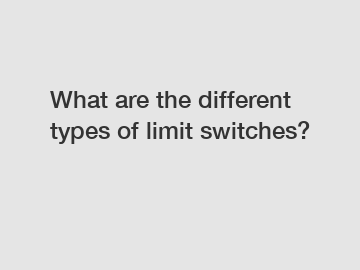What are the different types of limit switches?
Limit switches are essential components in the world of industrial automation and process control. They are used to detect the presence or absence of an object, as well as to provide feedback on the position of a machine or system. In essence, limit switches help ensure proper functioning and safety in various applications.
There are several types of limit switches available in the market, each with its own unique features and functionalities. In this blog post, we will explore the different types of limit switches and their applications.
1. Lever Arm Limit Switches.

Lever arm limit switches are perhaps the most common type of limit switch. As the name suggests, these switches use a lever arm to actuate the switch contacts. When the lever arm is moved by an external force, it triggers the switch to open or close, depending on the application requirements. Lever arm limit switches are often used in applications where a physical object needs to be detected or where precise positioning is required.
2. Plunger Limit Switches.
Plunger limit switches utilize a spring-loaded plunger to activate the switch contacts. When the plunger is depressed or released, it causes the switch to change its state. Plunger limit switches are commonly used in applications where a linear or vertical motion needs to be detected, such as in conveyor systems or control valves.
3. Rotary Limit Switches.
Rotary limit switches are designed to detect rotational movement. They consist of a shaft that rotates when a machine or equipment moves. As the shaft rotates, it actuates the switch contacts to signal the position of the rotating object. Rotary limit switches are often used in applications such as cranes, lifts, and rotating machinery.
4. Proximity Limit Switches.
Proximity limit switches use non-contact sensing technology to detect the presence or absence of an object. These switches rely on electromagnetic fields or infrared radiation to sense the proximity of an object, without the need for physical contact. Proximity limit switches are ideal for applications where contact-based switches may not be suitable, such as in dusty or hazardous environments.
5. Safety Limit Switches.
Safety limit switches are specially designed to ensure the safety of personnel and equipment in industrial settings. These switches often feature built-in safety mechanisms, such as safety interlocks or emergency stop buttons, to prevent accidents or hazards. Safety limit switches are widely used in applications where human safety is paramount, such as in machine guarding or emergency shutdown systems.
6. Snap Action Limit Switches.
Snap action limit switches have a unique mechanism that provides rapid switching action. These switches use a spring-loaded mechanism to quickly change the state of the switch contacts when triggered. Snap action limit switches are commonly used in high-speed applications where fast response times are essential, such as in automated machinery or robotics.
7. Sealed Limit Switches.
Sealed limit switches are designed to withstand harsh environmental conditions, such as moisture, dust, or chemicals. These switches are sealed with protective enclosures or gaskets to prevent damage from external elements. Sealed limit switches are ideal for outdoor or industrial applications where exposure to the elements is a concern.
In conclusion, limit switches play a critical role in ensuring proper operation and safety in industrial automation and process control systems. By understanding the different types of limit switches available, you can choose the right switch for your specific application requirements. Whether you need a lever arm switch for precise positioning or a safety switch for personnel protection, there is a limit switch available to meet your needs. So, next time you are designing or upgrading a system, consider the various types of limit switches and choose the one that best suits your requirements.
For more information, please visit What is an Example of a Limit Switch?, Top-roller Sealed Plunger Actuator Limit Switch, Micro Switch China.

Comments